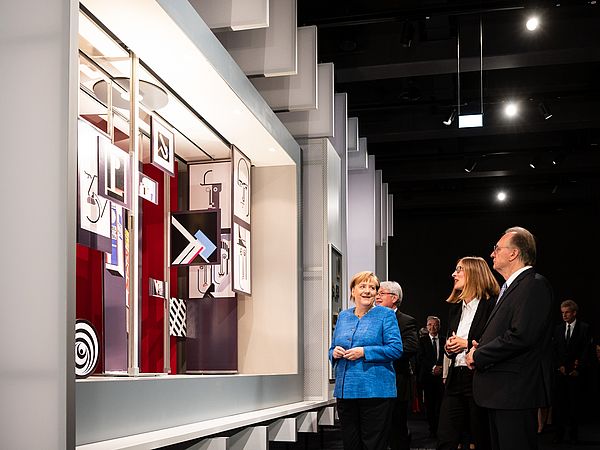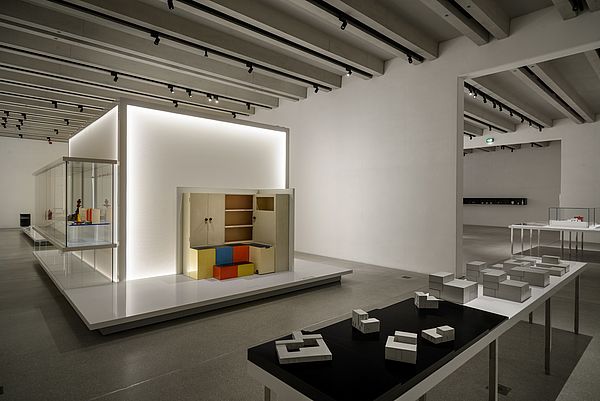Bauhaus-Archiv / Museum für Gestaltung
Berlin’s Bauhaus-Archiv / Museum für Gestaltung holds the world’s largest collection related to the history and the impact of the Bauhaus.

Headline
The extensive collection of the Bauhaus-Archiv / Museum für Gestaltung can be traced back to the initiative of German art historian Hans Maria Wingler, who began to gather together the Bauhaus' material heritage from all over the world in 1960. Today, the collection comprises works from all aspects of the Bauhaus members' work – including a collection of 14,000 architectural plans, a graphic collection of 12,000 items, a photo archive with 72,000 photographs, as well as objects and furniture from all phases of the Bauhaus' development. The holdings also include the private estate of Bauhaus director Walter Gropius, who also designed the largest exhibition object belonging to the Bauhaus-Archiv with his striking building beside the Landwehrkanal.
Kontakt
the temporary bauhaus-archiv / museum für gestaltung
Knesebeckstraße 1-2
10623 Berlin
U2 Ernst-Reuter-Platz
Location via Google Maps
Opening hours
Mon – Sat, 10 am – 6 pm
Free admission
T +49 (0) 30-254002-0
E bauhaus(at)bauhaus.de
Headline
From the very beginning, the archive has been a place of active knowledge production – whether in researching the history and impact of the Bauhaus or presenting and communicating it through exhibitions, publications and events. Today, a museum educational programme for all age groups complements these activities. In addition to the permanent exhibition “Bauhaus Collection”, which eloquently conveys the history and visions of the avant-garde school on the basis of original models, furniture, photographs and documents, the museum's exhibition and event programme also includes currently relevant themes and questions of contemporary design.
Around 120,000 people from all over the world visit the building every year. In order to do justice to the increasing number of visitors and the steadily growing collection, a new museum building for the Bauhaus-Archiv / Museum für Gestaltung is being built on the occasion of the Bauhaus anniversary. Walter Gropius' existing building will be renovated in line with conservation practice and will house the archive, library, and collection depots in future.
During the construction period, the temporary bauhaus archive in Berlin-Charlottenburg will be open to visitors. Over the next few years, the Bauhaus-Archiv / Museum für Gestaltung will be experimenting with forms of presentation, cooperation, events, and new content.
Bauhaus Museum Dessau
The Bauhaus Museum Dessau was built for the centenary of the founding of the Bauhaus and open on September 8, 2019. So far, it has only been possible to present the prized collection of the Bauhaus Dessau Foundation in a limited way in the Bauhaus Building.

headline
In the new museum, a suitable space to publicly display the collection is being created for the very first time. The collection of the Bauhaus Dessau Foundation comprises around 49,000 catalogued exhibits and is the second-largest collection worldwide on the theme of the Bauhaus. The new museum will have an exhibition space of 2,100 square metres and a total usable area of 3,500 square metres.
On November 1, 1976, the “Galerie am Sachsenplatz” in Leipzig charged the City of Dessau-Roßlau with the amount of 145,000 Marks for 148 works of Bauhäusler. Ranging from ceramics to furniture, it was a colourful mix. The items were exhibited for the first time in the Bauhaus Building, which was re-opened as Scientific-Cultural Centre in the GDR on the 4th of December 1976 on the occasion of the 50th anniversary of the Bauhaus. This purchase formed the basis of the collection of the Bauhaus Dessau Foundation, now consisting of more than 49,000 items. This first convolute will welcome the visitors of the Bauhaus Museum Dessau on the occasion of the centenary of the Bauhaus’ foundation.
Headline
The exhibition at the Bauhaus Museum Dessau is titled “Versuchsstätte Bauhaus. The Collection.” It features over 1,000 exhibits and tells the story of the famous school in Dessau. It describes Bauhaus as a vibrant place where people taught and learned, conducted artistic experiments and worked on industrial prototypes.
With a total of about 49,000 objects, the Bauhaus Dessau Foundation’s collection is the second largest Bauhaus collection world-wide – and one of the newest: The first purchase was made in 1976 when the Bauhaus Building was reopened as “Wissenschaftlich-Kulturelles Zentrum” in the former GDR. Since then, new objects have regularly been added. Student works, teaching notes, drafts and prototypes from the workshops in particular define the character of the collection.

Contact
Bauhaus Museum Dessau
Mies-van-der-Rohe-Platz 1
(an der Kavalierstraße)
06844 Dessau-Roßlau
Opening hours
Tue – Sun, 10 am – 6 pm
T +49 (0)340 – 6508250
E service(at)bauhaus-dessau.de
Headline
For this reason, the exhibition “Versuchsstätte Bauhaus” does not focus primarily on the famed design icons and the masters, but rather the school and the students: the daily reality of learning and teaching between the poles of creative design and industrial prototype production, artistic experiment and economic pressure, educational institution and emancipatory aspiration. The individual thematic sections concentrate on the teaching concept and the instruction provided, on the Bauhaus as a versatile “testing ground”, as a partner that cooperated with industry, and as a bustling and imaginative communicator.
The exhibition derives the Bauhaus design ideas with which we are so familiar today from the historical context, and at the same time does not omit mentioning the crises and constraining factors under which the epoch-making school fought to survive. In a climate of political change and cultural uncertainty, the Bauhaus community, a world-wide network, questioned the customary conventions of teaching, coexistence and gender relations. Similarly, in Dessau the school did not receive unequivocal support, but also faced criticism. “Versuchsstätte Bauhaus” highlights the many conflicts involved in the tussle to ensure art and design gained social relevance.
For the exhibition “Versuchsstätte Bauhaus” in the “Black Box” of the Bauhaus Museum Dessau, curated by Regina Bittner, Dorothée Brill and Wolfgang Thöner, the Berlin office chezweitz developed a scenography of changing modes of showing. It makes the complexity of the Bauhaus school a spatial experience.
Bauhaus Museum Weimar
On the occasion of the 100th anniversary of the State Bauhaus in Weimar, the Klassik Stiftung Weimar presented the grand opening of the new Bauhaus Museum Weimar in April 2019, showcasing the treasures of the world’s oldest Bauhaus collection. As a place of open encounter and discussion, the museum highlights the early phase of the most influential school of art and design of the 20th century, tying its history to questions of how we envision our living environment today and in the future.

Headline
Since 2010, the Bauhaus Collection of the Klassik Stiftung Weimar has also been expanded to include the famous Ludewig Design Collection, for which Berlin collector Manfred Ludewig has been gathering together more than 2,800 objects from all over Europe since the 1960s. His collection offers a unique overview of 200 years of design history and thus sets the Bauhaus into a broader cultural and design-historical context from the end of the 18th century onwards. Works by the Vienna Workshops are represented here, as well as by the Dutch group "De Stijl", furniture collections by the Thonet company, a collection of Braun products, or extensive collections featuring the work of individual designers such as Wilhelm Wagenfeld.
Headline
The exhibition “The Bauhaus Comes from Weimar”centres around the key issues, ideas and design proposals of the Bauhaus and its significance in our life today. The Bauhaus was a place of experimentation in the free and applied arts, design, architecture and education. Based on the question “How do we want to live together?”, the exhibition highlights key issues which are just as relevant today as they were in the Bauhaus era.

Contact
Bauhaus-Museum Weimar
Stéphane-Hessel-Platz 1
99423 Weimar
Germany
Opening hours
Mon – Sun, 9.30 am – 6 pm
T +49 (0)3643 545 400
E ticketshop(at)klassik-stiftung.de
info(at)klassik-stiftung.de
Headline
The exhibition draws on a unique group of objects – the world’s oldest museum collection of works from the Bauhaus workshops, established by Walter Gropius in the 1920s, which has since grown to approximately 13,000 objects. These include the famous table lamp by Wilhelm Wagenfeld and Carl Jakob Jucker, the teapot by Marianne Brandt, the lattice chair by Marcel Breuer, furniture by Ludwig Mies van der Rohe and graphic artworks by Paul Klee, László Moholy-Nagy and Lyonel Feininger. Alongside historical documents never shown before, the exhibition presents the extraordinary development of this influential school of art and design.
The Bauhaus Museum Weimar aims to reinterpret the history of the Bauhaus. It reveals how the Bauhaus initiated crucial processes of change at the start of the 20th century with respect to society, new forms of coexistence, new technologies, material studies and much more.
Bauhaus-Museum Weimar and Museum Neues Weimar are part of Quarters Weimar Modernism.